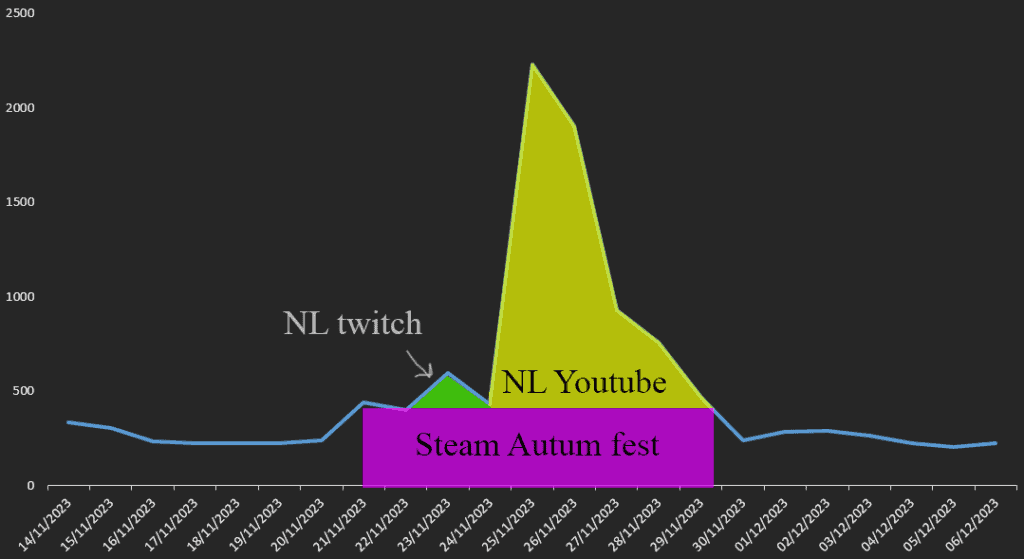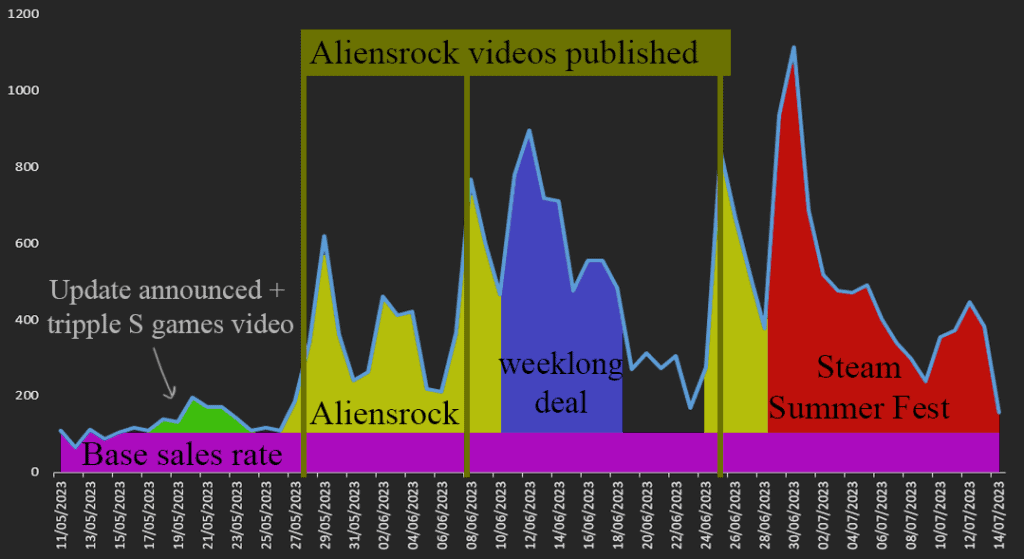Having a streamer play your game is probably the most effective way to market your game. One way to increase the odds of this happening is by sponsoring them. But how much should you pay a streamer to play your game while still making money?
In this post, I’ll analyze sales data from periods when streamers played The Ouroboros King (not sponsored) to try to answer that question. I’ll focus on how much value they generated for me, as what you pay streamers should be proportional to that.
Methodology
Perfectly attributing a sale to a marketing action is impossible, but we can try to make good estimates. I’ll follow these steps:
- Find a period where a streamer played my game with as few concurrent marketing actions as possible.
- Calculate a base sales rate, the expected daily revenue without any streamers playing the game. It could be the average daily sales of the 2 weeks before the streaming started. If there were significant marketing actions during that period, it may need to be adjusted.
- Attribute all revenue above the base rate to the streamer.
- Repeat points 2 and 3 for wishlists (WL) generated during the period and transform WL into value generated. This is done by multiplying by the WL conversion rate and the average value you get per sale. In my case 17% conversion * ~6$ / conversion = 1$/WL.
Case study 1: NorthernLion
NorthernLion (NL) played The Ouroboros King (TOK) in November 2023. Here are all the relevant facts that affected sales during that period:
- November 23rd: NL streamed TOK on Twitch for 45 minutes with ~7k viewers (data from sully gnome).
- November 25th: NL uploaded his gameplay to YouTube, the video is 35 minutes long and as of writing this has ~76k views. The views were very front-loaded (we can see that by December 15th it already had 72k views).
- Nov 21-29th: Steam’s Autumn Sale was running, so the base sales rate needs to be adjusted.
The following picture summarises my sales attribution:

- The Twitch stream generated 180$ in net revenue, ~130$ after the Steam cut (30%), and 7 wishlists
- The YouTube video generated 4.2k$ in net revenue, 2.9k$ after Steam, and 140 wishlists
In total NL playing TOK generated ~3k$ for me, which I’m very grateful for. In this case, the YouTube video was a lot more valuable to me than the Twitch stream. This may be because the YT video is almost as long as the stream. Usually, streamers play a game for a longer session and upload a shorter clip to YT.
Case study 2: Aliensrock
Aliensrock (AR) played The Ouroboros King before release and also in May and June. He was key to the game’s commercial success and I’ll always be thankful. We’ll focus on the 2nd period since during the first one there were lots of other things happening. You can see the WL graph in a previous post.
I did a first analysis and some results looked weird, so I talked to him and he shared with me his viewer data during the analyzed period. His views weren’t as front-loaded as NL’s. Here are all the relevant facts that affected sales during that period:
- May 29th: AR uploaded a YouTube video playing TOK that has 324k views, 172k during the analyzed period.
- June 8th: AR uploaded a YouTube video playing TOK that has 419k views, 108k during the analyzed period.
- June 12-18th: I held a weeklong discount on Steam.
- June 25th: AR uploaded a YouTube video playing TOK that has 397k views, 147k during the analyzed period.
- June 29th: Steam’s Summer Fest started.
- As far as I know, he didn’t stream it on any platform (it doesn’t appear on Sully Gnome), but I could be wrong.
The following picture summarises my sales attribution ARs videos:

AR’s videos generated 2k$, 1.6k$, and 1.4k$ in revenue (post steam cut) during the attribution period respectively, and 500, 300, and 288 wishlists, for a total of ~6.1k$ in value.
Attribution here is a lot more uncertain. There is a weird peak after AR’s first video that may be due to Steam’s discovery queue or YT’s algorithm bringing some views later. Also, one could argue that part of the weeklong deal and Steam Summer Fest should be attributable to AR. If we attribute all sales between AR’s first video and the start of Steam Summer Fest, the value generated goes up to ~10.3k$.
Estimating value before the stream
If measuring the impact after the stream isn’t even that easy, how would I go about estimating the value generated before the stream has happened?
Here’s what I’ll be doing from now on:
- Estimate how many views the stream/video will generate, based on past videos from the same creator
- Multiply the viewers by a value/view ratio
Here are the value/view ratios I got from my interactions with streamers:

For a 30-minute stream or YT video, TOK’s value/view ratio ranged between 0.011 and 0.043$ per view.
Note that AR’s ratio is probably smaller because he had already played my game in February and will be seeing diminishing returns. Additionally, it would be ~70% higher if we used the whole period (to which no doubt he contributed too).
NL’s ratio is probably inflated due to streaming during a period of discounts. Discounts probably have a multiplicative rather than additive effect on the value generated. But that’s too hard to model such a small dataset.
Another way to estimate an upper bound for the value/view is to divide the total income, by the total amount of views it’s gotten on YouTube. In my case, that’s 87k$/ 3466k views = 0.025$/ view, which is in the same order of magnitude. This method gives us an upper bound for the average value/ view since it only considers YouTube views.
These are my results and can be used as a starting point for other devs. Your value/ view will vary depending on game streamability, streamer-game fit, price, genre, …
If you’ve had similar interactions with streamers and want to share your numbers with me, I could aggregate them and publish the results in a follow-up post.
[Update] Case study 3: Gods vs Horrors Demo launch
On July 19th, 2024 I launched the demo of my upcoming game Gods vs Horrors. The Demo was covered by Retromation and Sifd twice, and some smaller YouTubers; and wasn’t covered on Twitch as far as I know. On August 14th I had 2,821 Wishlists and analyzed the coverage’s impact on Wishlists.
At the time of the analysis, the views on the videos were as follows:

Not all the wishlists were attributable to the videos, here’s a summary of my attribution model:
- 1,077 wishlists came from Asia (where I had little to no YT coverage) and were attributable to my Asia publisher’s marketing actions.
- 271 wishlists were attributable to Ads.
- 211 wishlists were attributable to the base Wishlist rate.
- 1,263 wishlists were left to attribute to the demo and YT coverage.
Assuming a conversion rate of 17%, a price of 15$, and a revenue-to-income ratio of 56% (20% goes to taxes and refunds, 30% of what remains to Steam), those wishlists represent 1,803$ in potential revenue.
Dividing the potential revenue by the number of views we get a value/view of 0.027$, in line with the other post-release examples.
[Update] Case study 4: Gods vs Horrors Olexa
In February 2025 Olexa played the Gods vs Horrors demo without any other marketing beats. The video had 26k views and netted a wishlist gain of 495, and a value of 707$. The value/view was of 0.027$.
What percentage of the value generated should go to the streamer?
There are many angles to answer this question, but no definitive solution.
You can treat this as ad-spend, and have a target Return On Ad Spend (ROAS). Doing a quick Google search tells me that a good ROAS is about 3, for every 1$ spent you should get 3 back. This would suggest you pay the streamer ~33% of the expected value generated.
If you treat it as a software sales commission, the standard pay is 8-12%.
From a revenue-maximizing perspective, one could offer 100% to the streamer to maximize the odds of them playing your game and hope to make money if the videos trigger Steam’s discovery queue. This is a negative-sum game where developers out-bid each other, and industry profits get siphoned away to streamers. It’s also very risky, as you’re spending the money upfront and may not recover it later.
I can’t make a definitive recommendation here. However, this methodology can serve as a tool to estimate the value the stream will provide before committing. This can help identify if a sponsorship will be unprofitable for you.
Conclusion
In short, if you’re thinking about sponsoring a content creator and don’t know how much to pay them: estimate how many views they’ll generate (based on previous videos) and multiply that by your sales-to-views ratio (estimated from previous interactions or you could use mine 0.010-0.025$/view, maybe higher if coupled with promotions).
Also, Youtube seems to be more valuable than Twitch because it reaches a bigger audience.
1 comment
Comments are closed.